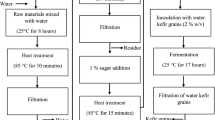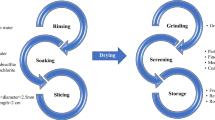Abstract
This study evaluated high pressure processing (HPP) for achieving greater than 5-log reduction of Escherichia coli O157:H7 in shiikuwasha (Citrus depressa Hayata) juices and compare quality parameters, including microbiological safety, total phenolic content (TPC), total flavanones (TFC), and polymethoxylated flavones, browning, volatile aromatic, and physicochemical properties of HPP-treated juice with those of high-temperature short-time pasteurized juice. A HPP of 600 MPa for 150 s was identified capable of achieving greater than 5.15-log reductions of E. coli O157:H7 in shiikuwasha juice. The microbiological shelf life of the juices were at least 28 days when processed at HPP for 600 MPa/150 s or HTST for 90 °C/60 s. The color, aromatic, and antioxidant contents (TPC, TFC, Tangeletin, Nobiletin) were well preserved after HPP, however, HTST resulted in a significant (p < 0.05) loss of antioxidant content (TPC (8.8%), Tangeletin (6.8%)), and negatively impacted the juice color. By the end of storage, the amount of these aroma relevant volatiles appears to still be higher in HPP pasteurized juices compared to their conventional counterparts. This study demonstrated that under optimal conditions of HPP can attain the same level of microbiological safety as thermal pasteurization and preserved the acceptable quality of shiikuwasha juice.


Similar content being viewed by others
Data availability
Yes.
Abbreviations
- HPP:
-
High pressure processing
- TPC:
-
Total phenolic content
- TFC:
-
Total flavanones
- PMF:
-
Polymethoxylated flavones
- HTST:
-
High-temperature short-time
- TA:
-
Titratable acidity
- HMF:
-
Hydroxymethylfurfural
- BI:
-
Browning index
- Y&M:
-
Yeast and mold
- TSS:
-
Total soluble solids
References
Akachi T, Shiina Y, Ohishi Y, Kawaguchi T, Kawagishi H, Morita T, Mori M, Sugiyama K (2010) Hepatoprotective effects of flavonoids from shekwasha (Citrus depressa) against D-galactosamine-induced liver injury in rats. J Nutr Sci Vitaminol 56:60–67
Ali N, Popovi V, Koutchma T, Warriner K, Zhu Y (2019) Effect of thermal, high hydrostatic pressure, and ultraviolet-C processing on the microbial inactivation, vitamins, chlorophyll, antioxidants, enzyme activity, and color of wheatgrass juice. J Food Process Eng 43:13036
Asikin Y, Fukunaga H, Yamano Y, Hou DX, Maedae G, Wada K (2014) Effect of cultivation line and peeling on food composition, taste characteristic, aroma profile, and antioxidant activity of Shiikuwasha (Citrus depressa Hayata) juice. J Sci Food Agri 94:2384–2392
AOAC, Official Methods of Analysis (15th edn). Association of Official Analytical Chemists, Arlington, VA. 1990.
Apichartsrangkoon A, Chaikham P, Srisajjalertwaja S (2014) Storage stability of aroma volatiles in ultra-high pressure and thermally treated Thai green-chili pastes (Nam PrigNhum). Food Bio 5:91–100
Buzrul S (2020) High hydrostatic pressure inactivation of microorganisms: a probabilistic model for target log-reductions. Int J Food Microbiol 309:108330
Fernandez MV, Denoya GI, Jagusa RJ, Vaudagnab SR, Agüero MV (2019) Microbiological, antioxidant and physicochemical stability of a fruit and vegetable smoothie treated by high pressure processing and stored at room temperature. LWT - Food Sci Technol 105:206–210
Gouvea FS, Padilla-Zakour OI, Worobo RW, Xavier BM, Walter EHM, Rosenthal A (2020) Effect of high-pressure processing on bacterial inactivation in açaí juices with varying pH and soluble solids content. Innov Food Sci Emerg Technol 66:102490
Hasni HN, Koh PC, Noranizan MA, Tahir PNFMM, Mohamad A, Limpot N, Hamid N, Aadil RM (2020) High-pressure processing treatment for ready-to-drink Sabah snake grass juice. J Food Process Prese 44:14508
Huang HW, Lung HS, Yang BB, Wang CY (2014) Responses of microorganisms to high hydrostatic pressure processing. Food Control 40:250–259
Huang HW, Wu SJ, Lu JK, Shyu YT, Wang CY (2017) Current status and future trends of high-pressure processing in food industry. Food Control 72:1–8
Kebede B, Lee PY, Leong SY, Kethireddy V, Ma Q, Aganovic K, Eyres GT, Hamid N, Oey IA (2018) Chemometrics approach comparing volatile changes during the shelf life of apple juice processed by pulsed electric fields, high pressure and thermal pasteurization. Foods 7:169
Lin SY, Chen IZ (2006) Native Citrus in Taiwan and current status of research and utilization. Seed Nursery 8:1–12
Liu Y, Zhao XY, Zou L, Hu XS (2013) Effect of high hydrostatic pressure on overall quality parameters of watermelon juice. Food Sci Technol Int 19:197–207
Lee YH, Charles AL, Kung HK, Ho CT, Huang TC (2010) Extraction of nobiletin and tangeretin from Citrus depressa Hayata by supercritical carbon dioxide with ethanol as modifier. Ind Crop Prod 31:59–64
Lee YS, Cha BY, Saito K, Choi SS, Wang XX, Choi BK, Yonezawa T, Teruya T, Nagai K, Woo JT (2011) Effects of a Citrus depressa Hayata (shiikuwasa) extract on obesity in high-fat diet-induced obese mice. Phytomedicine 18:648–654
Nayak PK, Rayaguru K, Krishnan KR (2017) Quality comparison of elephant apple juices after high-pressure processing and thermal treatment. J Sci Food Agri 97:1404–1411
High pressure processing (HPP) and inspection program personnel (IPP) verification responsibilities. FSIS Directive 6120.1
Raj AS, Chakraborty S, Rao PS (2019) Thermal assisted high-pressure processing of Indian gooseberry (Embilica officinalis L.) juice – Impact on colour and nutritional attributes. LWT - Food Sci Technol 99:119–127
Pei L, Hou S, Wang L, Chen J (2018) Effects of high hydrostatic pressure, dense phase carbon dioxide, and thermal processing on the quality of Hami melon Juice. J Food Process Eng 41:12828
Takenaka M, Nanayama K, Isobe S, Ozaki K, Miyagi K, Sumi H, Toume Y, Morine S, Ohta H (2007) Effect of extraction method on yield and quality of citrus depressa juice. Food Sci Technol Res 13:281–285
United States Department of Agriculture (USDA) (2012) High pressure processing (HPP) and inspection program personnel (IPP) verification responsibilities. FSIS Directive 6120.1
Wang CY, Huang HW, Hsu CP, Yang BB (2016) Recent advances in food processing using high hydrostatic pressure technology. Crit Rev Food Sci Nutr 56:527–540
Yuan B, Danao MGC, Stratton JE, Weier SA, Weller CL, Lu M (2018) High pressure processing (HPP) of aronia berry purée: effects on physicochemical properties, microbial counts, bioactive compounds, and antioxidant capacities. Innov Food Sci Emerg Technol 47:249–255
Zhang W, Dong P, Lao F, Liu J, Liao X, Wu J (2019) Characterization of the major aroma-active compounds in Keitt mango juice: comparison among fresh, pasteurization and high hydrostatic pressure processing juices. Food Chem 289:215–222
Acknowledgements
This research work was supported by the Ministry of Science and Technology, MOST 109-2622-E-150 -010 -CC2, Taiwan, Republic of China.
Funding
This research work was supported by the Ministry of Science and Technology, MOST 109–2622-E-150 -010 -CC2, Taiwan, Republic of China.
Author information
Authors and Affiliations
Contributions
Y-YL performed the analysis. J-HC performed the analysis. Y-CL performed the analysis. Y-TH collected the data, and contributed data or analysis tools. C-YW conceived and designed the analysis, contributed data or analysis tools, and wrote the paper.
Corresponding author
Ethics declarations
Conflict of interest
The authors declare that they have no conflict of interest to declare.
Additional information
Publisher's Note
Springer Nature remains neutral with regard to jurisdictional claims in published maps and institutional affiliations.
Rights and permissions
About this article
Cite this article
Lai, YY., Chen, JH., Liu, YC. et al. Evaluation of microbiological safety, physicochemical and aromatic qualities of shiikuwasha (Citrus depressa Hayata) juice after high pressure processing. J Food Sci Technol 59, 990–1000 (2022). https://doi.org/10.1007/s13197-021-05103-7
Revised:
Accepted:
Published:
Issue Date:
DOI: https://doi.org/10.1007/s13197-021-05103-7




